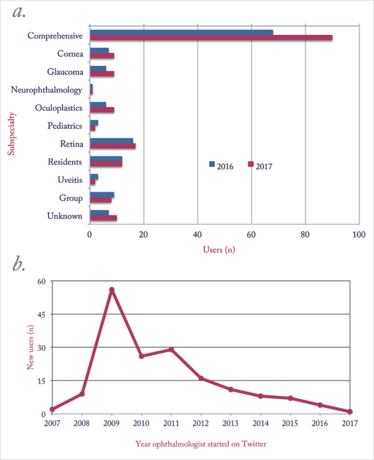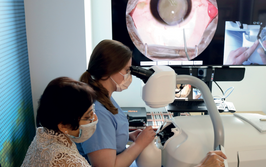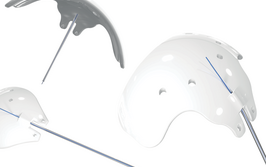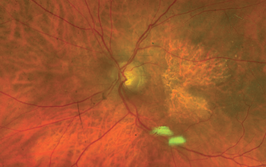
Is Twitter Dead?
To find out, we delved into the usage rates and trends among ophthalmologists…
At a Glance
- Twitter is a brilliant platform where vast amounts of information are disseminated every day
- Worldwide, Twitter use is declining – but are ophthalmologists following that trend?
- Analyzing Twitter usage between 2016 and 2017, we found that although the number of users joining the service was in decline, activity of existing users has increased
- We summarize our findings and offer our advice for ophthalmologists on social media.
Back in 2006, the microblogging website Twitter hatched. Despite a period of rapid growth in user numbers – particularly around 2009 and 2010 – usage today is declining (1). But does this trend of declining Twitter use also apply to tweeting ophthalmologists?
Following trends?
In 2016, Christiansen et al. (2) studied Twitter activity at the 2014 and 2015 annual AAO meetings, and found that there was a 43 percent increase in the numbers of ophthalmologists tweeting at the 2015 meeting. The majority of the tweets were centered on the meeting (66 percent) and tweeted by ophthalmologists at earlier career stages (63 percent; trainee or fewer than 10 years’ experience). Not only that, the number of impressions – the amount of people seeing those tweets – generated during the 2014 meeting (23.7 million) was more than 7.5 times greater than the impressions at a large emergency medicine conference (3.12 million), despite a similar number of tweets. What does this tell us? Ophthalmologists appear to have more active followers on Twitter than our emergency medicine colleagues.
Our study was designed to track ophthalmologists’ Twitter usage in 2016 and 2017, and collected data at two individual time points: May 27 and 28, 2016; and May 6 and 7, 2017 (3). Ophthalmologist accounts were identified using keywords such as ‘ophthalmologist’ and ‘eye surgeon’; ‘eye doctor’ was not used as it was difficult to differentiate between ophthalmologists and optometrists. To ensure that only active ophthalmology users were included in our study, we excluded those who hadn’t tweeted for 30 days as well as those who had no profile picture. In our analysis, we identified a surprisingly low number of active users worldwide – 138 in 2016 and 169 in 2017 – and that only one ophthalmologist joined twitter as an active user in 2017. Sixty percent of users were located in the US, with the majority residing on the east coast and in California. Analyzing users by subspecialty, the distributions were similar in both 2016 and 2017, with comprehensive ophthalmologists making up the largest volume by far, followed by retina specialists and residents (Figure 1a). Between 2016 and 2017, tweets, followers, and accounts followed by the user had all increased (56.9, 8.0 and 39.1 percent, respectively). Average tweets per month by users has also increased (38.6 percent) – although the potential impact of the ASCRS and ARVO annual meetings (which took place in May 2017) is not known. But despite the increased activity of ophthalmologists between 2016 and 2017, we found that the number of new users joining Twitter per year has actually decreased (Figure 1b). The upshot? The numbers of ophthalmologists joining Twitter might be decreasing, but the activity of users is increasing.

Figure 1. Ophthalmologist Twitter users by (a) subspecialty, and (b) and the year they joined Twitter (based on May 6–7 2017 tweets) – note, the number of new (ophthalmologist) Twitter has declined each year since 2011.
An ongoing education
So is Twitter dead? No. Twitter might have some flaws (See ‘Five Things We Want to See from Twitter’), but our results have shown that despite declining growth, Twitter still represents a great opportunity for ophthalmologists to educate, advocate, fundraise, mentor and market. The majority of the biggest names in medicine and other industries are on Twitter, including world leaders, celebrities and heads of companies. It offers a great opportunity to build a name for yourself and interact with your peers, as well as a platform for rapid dissemination of information.
We want to see more ophthalmologists on Twitter, but, more importantly, we want more effective Twitter users, so we would like to educate the existing flock. It can all start with something as simple as your username and profile. Our study identified a surprisingly small number of ophthalmologists actively using Twitter, but we know there are more out there who weren’t picked up in our study. Why? Because he or she simply don’t identify themselves as ophthalmologists on their profile, which is to their detriment; identifying yourself professionally as an ophthalmologist, eye surgeon and/or MD in your username and profile brings credibility. It gives you the authority to share information, and when you do share information – whether on dry eye or issues with contact lenses – people might be more likely to read it and be more trusting. Furthermore, the username itself should be easy for others to read and remember; the majority of people use social media through their mobile devices, so it is best to have a username without special characters.
Five things we want to see from Twitter
- The ability to edit tweets once they have been posted.
- A reminder of where users left last time, so that when they log back on, they may easily continue from where they were before (if they wish).
- Twitter recommendations personalized to users based on their previous activity.
- A ‘weeding out’ process for followers. We would recommend that Twitter could enlist a system where users can get a notification informing them if a follower has become inactive, and an option to unfollow them. This would also provide Twitter with an opportunity to alert the user they have been unfollowed and invite them back.
- Better integration with other platforms, such as LinkedIn, to facilitate easier tagging of users from other platforms.
Your Twitter activity should also be considered. Every user of social media is either a consumer or a producer – either sucking up information or generating content. We think most ophthalmologists are consumers because they don’t generate much content, but if you are actively generating content on Twitter, it’s good to consider what you are posting and why. Is your content mostly personal, social or professional? What are you highlighting from a professional standpoint? How effective is your content at reaching followers? We advise a more strategic approach to managing your account. What are your core competencies? Talking about leadership, ophthalmology or research all work well – but it’s good to have a focus. Effectively using hashtags and tagging other users to promote engagement is also important, of course.
We’re passionate about effective social media usage because, whether you like it or not, you will have an online footprint, so you should take control of the content that people can find. Whether you are a consumer or a producer, your profile should be professional and free of personal information – and you should ensure that your activity is in line with how you wish to be perceived by your followers. Most importantly, don’t be afraid to take the opportunity!
Pavan Angadi is an ophthalmology resident at Howard University Hospital, Department of Ophthalmology, Washington D.C.
Robert F. Melendez is an ophthalmologist at Eye Associates of New Mexico, Albuquerque, and Assistant Clinical Professor in the Department of Surgery/Division of Ophthalmology at the University of New Mexico in Albuquerque. He is also executive director of The Juliette RP Vision Foundation and Founder of Social Media Page Creators.
- Statista.com, “Annual Twitter user growth rate worldwide from 2015 to 2020”. Available at: bit.ly/2CabDvS. Accessed: December 15, 2017.
- SM Christiansen et al., “Twitter at the 2014 and 2015 annual meetings of the American Academy of Ophthalmology”, Ophthalmol, 123, 1835–1837 (2016). PMID: 27067923.
- P Angadi et al. “Is Twitter dead? Usage rates and trends among ophthalmologists”. Presentation at the annual meeting of the American Academy of Ophthalmology, November 11–14, 2017; New Orleans, USA.
Pavan Angadi is an ophthalmology resident at Howard University Hospital, Department of Ophthalmology, Washington D.C.
Robert F. Melendez is an ophthalmologist at Eye Associates of New Mexico, Albuquerque, and Assistant Clinical Professor in the Department of Surgery/ Division of Ophthalmology at the University of New Mexico in Albuquerque. He is also executive director of The Juliette RP Vision Foundation and Founder of Social Media Page Creators.













